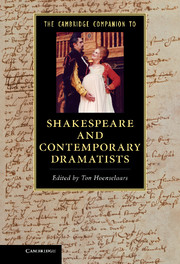Book contents
- Frontmatter
- Contents
- Illustrations
- Contributors
- Preface
- Chronology of the life and work of Shakespeare and contemporary dramatists
- 1 John Lyly and the University Wits
- 2 Thomas Kyd and the Elizabethan blockbuster
- 3 ‘The words of Mercury’
- 4 The dyer’s hand
- 5 Urbane John Marston
- 6 Thomas Dekker and the emergence of city comedy
- 7 Shakespeare
- 8 Thomas Heywood
- 9 George Chapman’s learned drama
- 10 Francis Beaumont and John Fletcher’s tragicomedy as musical melodrama
- 11 Thomas Middleton and the early modern theatre
- 12 John Webster
- 13 John Ford
- 14 Philip Massinger
- 15 Richard Brome and the idea of a Caroline theatre
- 16 Troublesome histories
- Select bibliography
- Index
- References
8 - Thomas Heywood
Dramatist of London and playwright of the passions
Published online by Cambridge University Press: 05 December 2012
- Frontmatter
- Contents
- Illustrations
- Contributors
- Preface
- Chronology of the life and work of Shakespeare and contemporary dramatists
- 1 John Lyly and the University Wits
- 2 Thomas Kyd and the Elizabethan blockbuster
- 3 ‘The words of Mercury’
- 4 The dyer’s hand
- 5 Urbane John Marston
- 6 Thomas Dekker and the emergence of city comedy
- 7 Shakespeare
- 8 Thomas Heywood
- 9 George Chapman’s learned drama
- 10 Francis Beaumont and John Fletcher’s tragicomedy as musical melodrama
- 11 Thomas Middleton and the early modern theatre
- 12 John Webster
- 13 John Ford
- 14 Philip Massinger
- 15 Richard Brome and the idea of a Caroline theatre
- 16 Troublesome histories
- Select bibliography
- Index
- References
Summary
The one thing most scholars know about Thomas Heywood is his claim, included in his 1633 preface to The English Traveller, to have had ‘an entire hand, or at the least a maine finger’ in 220 plays. We don’t know if this is true, but it seems probable, given the length of Heywood’s career (he started writing in the 1590s and continued until his death in 1641), his productivity in many genres and his apparent penchant for collaboration. He was, for example, a probable collaborator in The Book of Sir Thomas More (1592–3) and a certain collaborator in plays such as The Witch of Edmonton (1621). A man of modest origins, Heywood was the son of a country parson, and his studies at Cambridge were cut short when his father died in 1593. Settling in London, he spent most of the rest of his life in the city, becoming in every way a man of London and of the London theatre world.
While the majority of Heywood’s writing was done for the theatre, he also wrote a number of works of poetry, including the early ‘Oenone and Paris’ (1594), a narrative poem resembling Shakespeare’s ‘Venus and Adonis’, and Troia Britannica (1609), a history of the world to the present; a defence of the theatre entitled An Apology for Actors (1607); two collections of prose stories about women, Gunaikeion (1624) and Nine the Most Worthy Women of the World (1640); and a rambling philosophical compendium entitled The Hierarchy of the Blessed Angels (1635). In the 1590s Heywood was associated with the theatrical enterprises of Philip Henslowe and wrote plays for the Lord Admiral’s Men at the Rose. In 1599 the Earl of Derby’s Men staged his two-part play, Edward IV, and soon thereafter he joined the Earl of Worcester’s Company, which metamorphosed into the Queen Anne’s Men after King James ascended the English throne in 1603. With the Queen’s Men, playing primarily at the Red Bull theatre in Clerkenwell, Heywood had a long and fruitful relationship.
- Type
- Chapter
- Information
- Publisher: Cambridge University PressPrint publication year: 2012
References
- 1
- Cited by

